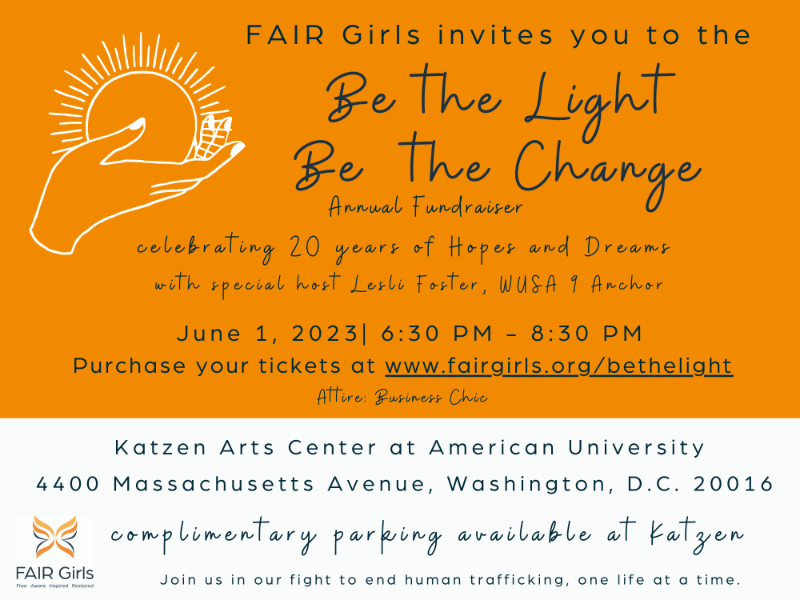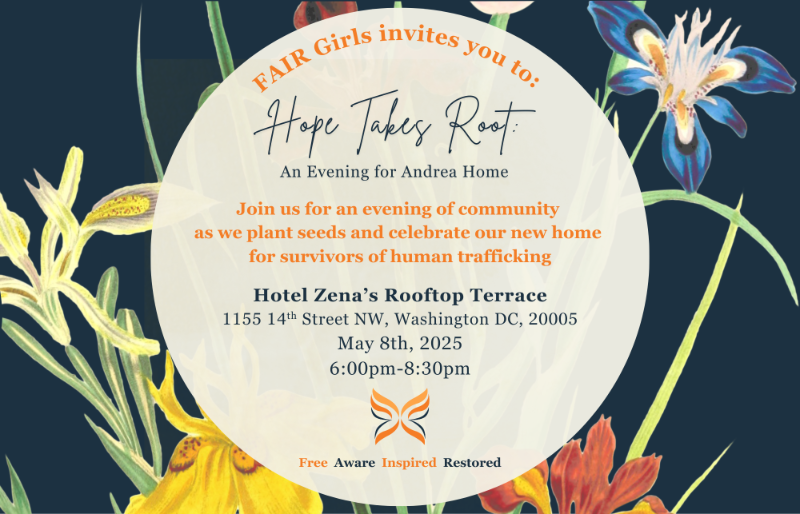FAIR Girls Admin
December 2023
FAIR Girls Fundraiser 2023 Postponed
FAIR Girls Fundraiser 2023
2023 Fundraiser: Be the Light Be the Change

November 2022
July 2021
Asian American Women’s Vulnerabilities to Exploitation Rooted in Stereotypes and Racism
Since the start of COVID-19, reports of violent attacks towards Asian Americans have skyrocketed. From elders being slashed with box cutters and pushed onto the street to the March 17, 2021 shootings at Atlanta massage businesses, Asian Americans remain fearful of leaving their homes or having “China Virus” spat at them. Further, Asian American women reported experiencing hate incidents 2.3 times more than men (Jeung). Unfortunately, this gendered hostility and outright brutality is not new. Rather, it is deeply embedded into American history.
Starting with the Page Act of 1875 targeting China, Japan, and “any Oriental country,” it declares that “the importation into the United States of women for the purposes of prostitution is hereby forbidden” (“Barring Female Immigration”). The Act oversexualizes Asian women, assuming that they are inherently sexual and therefore conflating female Asian identity with illicit sexual services. Following, during the Philippine-American War “American soldiers referred to the Filipinas as ‘little brown f***ing machines powered by rice’” resulting in a sex industry emerging to cater to the U.S. military men “offering ‘a girl for the price of a burger” (Woan, 283). This continued through the Korean War and Vietnam War with regulated prostitution services known as “camp towns” similarly catering to U.S. military men (“United States Military”). It should be noted that many of the women servicing the military men were forced into doing so either by poverty, coercion, or other circumstances. Today, the trend continues with sex tourism in South East Asia booming, many of the buyers being Western men traveling explicitly for the sexual services from young women and girls (minors). These historical relations reinforced and solidified the hypersexualization and objectification of Asian women, namely East and Southeast Asian women, that is ever present today.
Social structures additionally contributed to the current racialization and stereotyping of Asian communities and individuals. The Model Minority Myth is a widespread yet harmful characterization. It positions Asian Americans—mostly East Asians and South Asians—to be a group of polite and law-abiding individuals who have reached great success via intrinsic ability and sheer hard work (“What Is the Model Minority Myth?”). The New York Times’ 1966 article “Success Story, Japanese American Style” and Time Magazine’s 1987 cover on “Those Asian-American Whiz Kids” both perpetuate this false idea that Asian Americans have “made it” despite centuries of discrimination and marginalization. Therefore, other marginalized groups should be able to do the same, specifically Black and Brown communities. The Model Minority Myth is used as a wedge in this way to pit Asian communities against others, drawing Asians closer to whiteness. This caricature of meritocracy has rendered the greater Asian American community to be equated with a small group of high-achieving individuals. As a result, Asian Americans are rendered monolithic East Asians who are smart, docile, and diligent. Tragically, these misconceptions gloss over the largest ethnic wealth gap in the U.S. with some Asians in the top 10% of income distribution earning 10.7 times as much as those Asians in the bottom 10% (Rakesh), failing to offer support to more marginalized ethnic groups like Laotians and Bhutanese. It also explicitly and erroneously suggests that Asian Americans do not face present-day racism.
Orientalism is another contributor to the brutality seen today. It is a Eurocentric way of viewing Asia as “exotic, backward, uncivilized, and at times dangerous” in contrast to “civilized” and modest Europe (“What is Orientalism”), positioning Asia and diasporic Asians as “foreign” in their own countries. Consequently, Asian American women are at the heart of this. They are sexualized as “exotic” objects for the white gaze and white male consumption via two tropes: “Dragon Lady” and “China Doll”—also called the “Butterfly” or “Lotus Blossom.” The “Dragon Lady” is sensual, selfish, fierce (Lee, 3). She weaponizes her sexuality but is ultimately defeated to ensure white dominance (Lee, 3). Hu Li in Rush Hour is a prime example. On the other hand, the “China Doll” is docile, selfless, emotional, and submissive (Lee, 1). She often lacks agency, experiences little to no character development, and is depicted in an infantilizing way, like Cio-Cio San in Madame Butterfly. These two caricatures fortify understandings that Asian women are submissive commodities whose sole purpose is to be used and dominated by others.
Tragically, all of these harmful notions became deadly on March 17, 2021 when eight people were killed, six of whom were Asian, by a white man in Georgia. The shooter claimed to be motivated by a “sex addiction,” which was as a “temptation to eliminate,” rather than being motivated by race (McLaughlin). This hate crime cannot be viewed as just an erroneous act of misogyny, racism, or xenophobia though. The deep intersectionality of race, gender, class, and immigration status must be highlighted. The locations targeted were explicitly marketed as Asian-owned businesses offering legal massage and spa services, not illicit sexual ones. Yet due to the historical and social conflation of Asian female identity and the massage industry with illicit sexual activity, the shooter assumed the employees were offering sex and therefore must be “eliminated.” In this case along with many others, Asian women are hypersexualized and expected to willingly offer sex. This has been normalized through media like in the movie Full Metal Jacket and the song “Asian Girlz” by Day Above Ground. It also must be noted that many in the massage industry are working to pay back debt, have a great sense of responsibility in the immediate family or extended community, and/or have limited job opportunities due to immigration status, language ability, or job qualifications (Racism & Misogyny). They may be told the narrative that they are only able to work in the massage business due to their limited skills, rendering them vulnerable to exploitation from buyers who are often white men, law enforcement, and massage business owners to then reinforce fear or false claims that the massage business is the only place that they can work (Racism & Misogyny).
Unfortunately, all of these misconceptions and tropes bar Asian Americans from various leadership positions, exploit them for labor or sex, commodify them, and villanize them on a local and national scale. This legacy of brutality will continue unless proper education, deeper understanding, and community support is pursued. To start:
- Look into the historical and racialized roots of U.S. colonialism and imperialism in Asia.
- Ask yourself “what assumptions do you have about API communities?” (See e.g., Asian women are submissive, all Asians are smart).
- Offer Support (check in on your Asian friends, co-workers, and neighbors; donate to API organizations; encourage your school/workplace to incorporate API history & AAPI stories; volunteer at a local organization supporting API communities).
Sources
“Asian-American Whiz Kids – Aug. 31, 1987.” TIME.com, 2019, content.time.com/time/covers/0,16641,19870831,00.html. Accessed 23 May 2021.
“Barring Female Immigration” Digital History, 2021, www.digitalhistory.uh.edu/disp_textbook.cfm?smtid=3&psid=21#:~:text=Digital%20History&text=Annotation%3A%20In%201875%2C%20the%20U.S.,coming%20to%20the%20United%20States. Accessed 18 May 2021.
Jeung, Russell, Aggie Yellow Horse, Tara Popovic, and Richard Lim. “Stop AAPI Hate National Report.” Stop AAPI Hate, 2021. https://secureservercdn.net/104.238.69.231/a1w.90d.myftpupload.com/wp-content/uploads/2021/03/210312-Stop-AAPI-Hate-National-Report-.pdf. Accessed 20 May 2021.
Lee, Joey. “East Asian ‘China Doll’ or ‘Dragon Lady’?” Bridges: An Undergraduate Journal of Contemporary Connections, vol. 3, 2018, scholars.wlu.ca/cgi/viewcontent.cgi?article=1026&context=bridges_contemporary_connections.
McLaughlin, Eliott, Casey Tolan, and Amanda Watts. “Police: Atlanta Shooting Suspect May Have a Sex Addiction.” CNN, 17 Mar. 2021, www.cnn.com/2021/03/17/us/robert-aaron-long-suspected-shooter/index.html. Accessed 24 May 2021.
Pettersen, William. “Success Story, Japanese-American Style; Success Story, Japanese-American Style (Published 1966).” The New York Times, 2021, www.nytimes.com/1966/01/09/archives/success-story-japaneseamerican-style-success-story-japaneseamerican.html. Accessed 23 May 2021.
Racism & Misogyny: The Exploitation of Asian Women in the Massage Industry. World Without Exploitation, 25 March 2021. https://vimeo.com/530833937/6abdae2efd Webinar.
Rakesh Kochhar, and Anthony Cilluffo. “Income Inequality in the U.S. Is Rising Most Rapidly among Asians.” Pew Research Center’s Social & Demographic Trends Project, Pew Research Center’s Social & Demographic Trends Project, 12 July 2018, www.pewresearch.org/social-trends/2018/07/12/income-inequality-in-the-u-s-is-rising-most-rapidly-among-asians/. Accessed 23 May 2021.
“United States Military and Prostitution in South Korea.” Wikipedia, 5 Apr. 2021, en.wikipedia.org/wiki/United_States_military_and_prostitution_in_South_Korea. Accessed 18 May 2021.
“What Is the Model Minority Myth?” Learning for Justice, 2019, www.learningforjustice.org/magazine/what-is-the-model-minority-myth. Accessed 17 May 2021.
“What is Orientalism?” Arabstereotypes.org, 2013, arabstereotypes.org/why-stereotypes/what-orientalism. Accessed 23 May 2021.
Woan, Sunny. “White Sexual Imperialism: A Theory of Asian Feminist Jurisprudence,” Journal of Civil Rights and Social Justice, vol. 14, 2008, p. 275-301, scholarlycommons.law.wlu.edu/cgi/viewcontent.cgi?article=1243&context=crsj.

